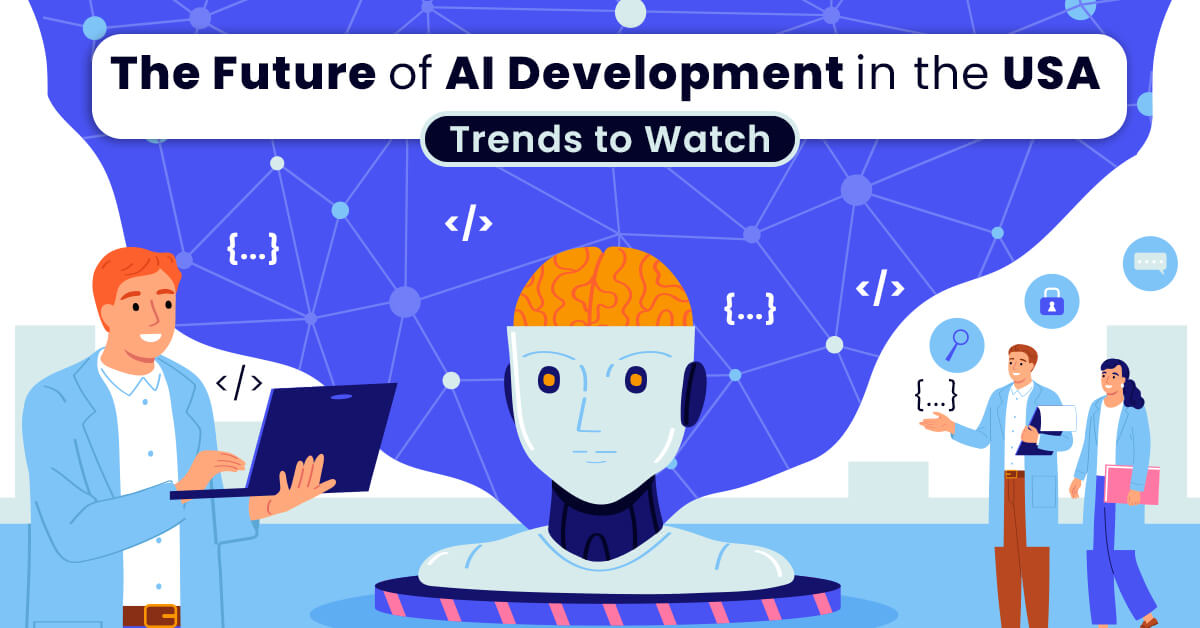The Future of AI Development in the USA: Trends to Watch
Technology has moved far beyond being just a buzzword—it’s now deeply woven into the way businesses function. In the USA, more and more industries are turning to advanced tech solutions to improve their processes, create better customer experiences, and gain an edge over their competition. From automating routine tasks to making decisions based on real-time data, companies are seeing technology transform the way they operate.
But this is just the beginning. As technology continues to evolve, we’ll see even more sophisticated applications emerge, along with new challenges and deeper integration into our everyday lives. This article will look at the key trends that are shaping the future of tech development in the USA, showcasing real-world examples of how businesses can make the most of it.
We’ll also explore how these innovations will impact the workforce, raise new ethical questions, and push forward some amazing breakthroughs in science and everyday life. Ready to dive in? Let’s explore what’s next!
Key Trends Shaping the Future of AI Development in the USA
The Rise of Generative AI
Generative AI has rapidly emerged as one of the most exciting developments in the AI space. This type of AI goes beyond analyzing data and making predictions—it can create new content, from text to images to music. Generative AI models, such as OpenAI’s GPT-4 and DALL-E, have already made a significant impact on industries like marketing, content creation, and software development.
Generative AI’s potential lies in its ability to automate tasks that were once thought to require human creativity. For instance, companies are now using generative AI to create personalized marketing materials, develop virtual assistants, and even generate software code. The rise of generative AI is expected to continue as businesses discover more ways to use it to increase efficiency and innovation.
In content creation, AI-generated articles, reports, and even video scripts are becoming common. Companies are using AI models to generate content that resonates with specific target audiences, reducing the time and cost associated with traditional methods. Furthermore, these models can improve customer service through AI-powered chatbots that understand and respond in real-time.
Generative AI is not just a tool for businesses; it’s revolutionizing industries. In entertainment, for example, generative AI is being used to create lifelike avatars and generate entire video game worlds. In marketing, brands are utilizing generative AI to personalize ads based on user preferences. As the demand for AI-driven solutions increases, businesses will continue to invest in generative AI technologies to remain competitive, often partnering with an experienced artificial intelligence company in the USA to develop cutting-edge applications.
Smaller, More Efficient AI Models
While large-scale AI models like GPT-3 and GPT-4 have garnered much attention, there’s a growing trend toward smaller, more efficient models. These smaller models, often referred to as small language models (SLMs), are designed to be run on devices with limited computational power, such as smartphones or Internet of Things (IoT) devices. This trend is significant because it democratizes access to AI, enabling more industries and consumers to use AI without the need for expensive infrastructure.
The development of smaller AI models allows companies to deploy AI solutions in more resource-constrained environments, offering greater accessibility and scalability. For instance, these models can be used in industries such as manufacturing, where edge devices require AI for real-time decision-making without relying on cloud computing.
Smaller models are also beneficial for mobile applications. Companies can integrate AI into their apps, offering features such as real-time language translation, voice recognition, and personalized recommendations. This trend will continue to expand the use of AI across sectors, providing more opportunities for businesses to integrate AI into their daily operations.
In the future, we can expect more advancements in the development of smaller AI models. As businesses seek to reduce costs and enhance user experiences, smaller models will become more prevalent, making AI accessible to a wider audience.
AI for Decision-Making and Strategic Planning
As companies in the USA face increasing competition, the ability to make informed, data-driven decisions is becoming a key differentiator. AI has a powerful role to play in decision-making and strategic planning by analyzing massive datasets and providing actionable insights. With AI, businesses can predict market trends, assess risks, and identify growth opportunities.
In finance, for example, AI algorithms can analyze vast amounts of data to detect patterns and predict stock market movements. In retail, AI can help businesses optimize supply chains, manage inventory, and personalize customer experiences. AI-driven insights are enabling companies to make faster, more accurate decisions, giving them a competitive edge.
AI is not just limited to operational decision-making. It is also being used in strategic planning, where AI models analyze data to help businesses set long-term goals and identify new markets. By leveraging AI, companies can reduce uncertainty and make more informed decisions that align with their overall business strategy.
As AI continues to evolve, its role in decision-making and strategic planning will expand. Companies that can harness the power of AI for these purposes will be better positioned to navigate the complexities of the modern business landscape.
Multimodal AI
Multimodal AI is the next frontier in AI development. While traditional AI models are typically designed to process a single type of data, such as text or images, multimodal AI can process and integrate multiple types of data, including text, images, audio, and video. This ability to understand and synthesize information from different sources makes multimodal AI particularly powerful.
One of the most exciting applications of multimodal AI is in healthcare. For example, AI models can analyze both medical images and patient records to provide more accurate diagnoses. In the automotive industry, multimodal AI is being used in autonomous vehicles to process visual and audio data simultaneously, allowing the vehicles to make real-time decisions.
Multimodal AI is also being used to enhance user experiences in everyday applications. For instance, AI-powered virtual assistants can process voice commands while also interpreting visual data from a camera. This creates a more seamless and intuitive interaction between humans and machines, improving the overall user experience.
As multimodal AI continues to develop, we can expect to see its integration in more industries. Companies that adopt multimodal AI will be able to offer richer, more personalized services to their customers, further solidifying their place in the market.
The Industrialization of Machine Learning
As AI becomes more widespread, there is a growing need to standardize and scale machine learning solutions across industries. The industrialization of machine learning refers to the process of making machine learning more efficient, scalable, and reliable. This trend is particularly important for large enterprises that rely on machine learning models to automate processes and make data-driven decisions.
Companies are increasingly investing in machine learning platforms that enable them to build, deploy, and manage machine learning models at scale. These platforms provide tools for data processing, model training, and deployment, allowing businesses to integrate machine learning into their operations without needing specialized expertise.
For example, in the financial sector, companies are using industrialized machine learning to automate fraud detection, streamline customer service, and optimize trading strategies. In manufacturing, machine learning is being used to improve predictive maintenance and enhance quality control.
As more companies recognize the value of machine learning, the demand for scalable, standardized solutions will continue to grow. Businesses that can effectively industrialize their machine learning processes will be able to stay ahead of the competition by leveraging AI to drive innovation and efficiency.
AI in Edge Computing
Edge computing refers to the practice of processing data closer to the source rather than relying on centralized data centers or cloud servers. With the rise of AI, edge computing is becoming increasingly important, as it allows for real-time data processing and decision-making in environments where latency and bandwidth are critical factors.
AI in edge computing is particularly relevant in industries like manufacturing, where IoT devices are used to monitor production processes and equipment. By deploying AI models directly on these devices, businesses can make real-time decisions that improve efficiency and reduce downtime.
For example, in smart cities, AI models deployed at the edge can analyze data from traffic cameras and sensors to optimize traffic flow, reduce congestion, and improve safety. Similarly, in agriculture, AI-powered drones can analyze crop data in real time, enabling farmers to make immediate decisions about irrigation and pest control.
As AI technology continues to advance, edge computing will become a critical component of AI development. Companies that adopt AI-powered edge computing solutions will be able to process data more efficiently, reduce costs, and improve decision-making.
Also Read:
Impact of artificial intelligence on personalized running recommendations
AI in Cybersecurity
In today’s digital age, cybersecurity is more important than ever. As cyberattacks become more sophisticated, businesses need advanced solutions to protect their data and systems. AI is playing a crucial role in cybersecurity by automating threat detection and response.
AI-Powered Automation in Customer Service
Customer service is an area where AI is making significant strides, and businesses in the USA are increasingly turning to AI-powered automation to improve efficiency and customer experience. AI tools, such as chatbots and virtual assistants, have transformed customer support by offering 24/7 service, responding to high volumes of customer inquiries, and providing personalized recommendations in real-time.
For example, chatbots can handle routine queries, such as order tracking or account management, allowing human agents to focus on more complex issues. Virtual assistants equipped with natural language processing (NLP) can understand and respond to customers’ questions in a conversational tone, providing a seamless experience. This level of automation not only reduces costs for businesses but also enhances customer satisfaction by offering instant responses and minimizing wait times.
Additionally, AI-driven customer service tools can analyze customer interactions to detect patterns, identify common issues, and provide insights that businesses can use to improve their products or services. As AI technology continues to evolve, we can expect more advanced AI-powered solutions that will further revolutionize customer service, making it more proactive and personalized.
AI in Quantum Computing
The integration of AI and quantum computing is one of the most anticipated developments in the tech world. While quantum computing is still in its infancy, it has the potential to solve problems that are too complex for classical computers, and AI will be instrumental in unlocking that potential. Quantum computers can process vast amounts of data at incredible speeds, which can significantly enhance AI algorithms, particularly in fields such as drug discovery, financial modeling, and cryptography.
In the USA, companies like IBM and Google are at the forefront of quantum computing research, working to develop quantum processors that can work in conjunction with AI to solve complex problems faster than ever before. For instance, in drug discovery, quantum AI can simulate molecular interactions with a high degree of precision, speeding up the process of identifying potential treatments.
As quantum computing technology matures, it will open up new possibilities for AI applications in industries that require massive computational power. Businesses that invest in quantum AI early will be well-positioned to capitalize on its benefits, gaining a competitive edge in industries like finance, healthcare, and logistics.
AI’s Impact on the Workforce
AI’s rapid development is not only changing how businesses operate but also how people work. As AI continues to automate tasks and processes, there are both opportunities and challenges for the workforce in the USA. The future of work will likely be characterized by collaboration between humans and machines, where AI takes on repetitive tasks, allowing human workers to focus on more complex, creative, and strategic roles.
Shifting Job Roles and Skills
AI is transforming various job roles across industries, from software development to customer service. Jobs that involve repetitive tasks, such as data entry, scheduling, or even some aspects of customer support, are increasingly being automated. However, this does not necessarily mean job losses. Instead, many roles are evolving, requiring workers to develop new skills in AI, data analysis, and problem-solving.
For example, in the manufacturing sector, AI-powered robots are automating tasks like assembly and quality control. This has led to a shift in job roles, with workers now required to manage, program, and maintain these robots rather than performing manual tasks. Similarly, in finance, AI is automating fraud detection and risk analysis, which means employees need to focus on interpreting data and making strategic decisions based on AI insights.
As AI becomes more integrated into the workforce, companies will need to invest in reskilling and upskilling their employees. By providing training in AI-related skills, businesses can ensure that their workforce is prepared for the future of work and able to collaborate effectively with AI technologies.
AI as a Complement to Human Workers
AI is not a replacement for human workers—it’s a complement. By automating repetitive and mundane tasks, AI allows employees to focus on tasks that require creativity, critical thinking, and emotional intelligence. For instance, AI can handle data processing and basic customer inquiries, while human workers can focus on building relationships with clients, solving complex problems, and driving innovation.
In healthcare, for example, AI tools are being used to analyze medical images, freeing up radiologists to focus on more nuanced aspects of patient care, such as diagnosing rare conditions or developing personalized treatment plans. Similarly, in marketing, AI algorithms can analyze consumer data and create targeted campaigns, allowing marketing teams to focus on creative strategies and brand development.
As AI continues to advance, the partnership between humans and AI will become even more crucial. Businesses that embrace this collaboration will be able to harness the full potential of AI, improving productivity and creating new opportunities for growth.
Artificial Intelligence and Ethics: Things to Consider
As AI becomes more powerful and pervasive, questions about ethics, fairness, and transparency are becoming increasingly important. Ensuring that AI is developed and deployed responsibly will be crucial for businesses and governments alike.
Addressing Bias in AI Models
One of the biggest challenges facing AI today is bias in AI models. AI systems learn from the data they are trained on, and if that data contains biases, the AI can perpetuate or even amplify those biases. This is particularly concerning in industries like healthcare, finance, and law enforcement, where biased AI models can lead to unfair treatment of individuals based on race, gender, or socioeconomic status.
Addressing bias in AI requires a multi-faceted approach. Companies need to invest in diverse datasets that represent a wide range of demographics and experiences. Additionally, AI developers need to implement fairness and transparency protocols in their algorithms, ensuring that AI decisions are explainable and auditable.
In the USA, there is growing recognition of the need for ethical AI. Companies and government bodies are working together to create frameworks and regulations that promote the responsible use of AI, ensuring that it benefits all members of society without perpetuating harm.
Data Privacy and Security
As AI systems become more integrated into our lives, they collect vast amounts of data, raising concerns about data privacy and security. AI models rely on personal data to function, whether it’s customer data used for personalized marketing or health data used for medical diagnostics. Ensuring that this data is stored securely and used responsibly is critical.
In the USA, data privacy laws such as the California Consumer Privacy Act (CCPA) have been enacted to give consumers more control over their personal information. However, as AI continues to evolve, businesses will need to stay ahead of regulatory requirements and adopt privacy-preserving AI technologies, such as differential privacy and federated learning, to protect user data.
AI-powered cybersecurity solutions are also becoming increasingly important. These solutions can detect and respond to cyberattacks in real-time, reducing the risk of data breaches and protecting sensitive information. As cyber threats become more sophisticated, businesses will need to invest in AI-driven security measures to stay ahead of the curve.
AI’s Role in Scientific Discovery and Global Challenges
AI is not just transforming businesses—it’s also playing a crucial role in solving some of the world’s most pressing challenges, from climate change to healthcare. As AI technologies become more advanced, they are enabling breakthroughs in scientific research and helping to address global problems.
AI in Climate Change and Sustainability
Climate change is one of the biggest challenges facing the world today, and AI is playing a key role in finding solutions. AI can analyze vast amounts of environmental data, helping scientists predict weather patterns, monitor deforestation, and optimize renewable energy sources.
For example, AI-powered tools are being used to optimize energy grids, reducing energy waste and improving the efficiency of renewable energy sources like solar and wind. In agriculture, AI is helping farmers reduce water usage, improve crop yields, and minimize the use of pesticides, contributing to more sustainable farming practices.
As the fight against climate change continues, AI will play an increasingly important role in helping governments and businesses reduce their carbon footprints and create a more sustainable future.
AI in Healthcare
In healthcare, AI is revolutionizing medical research, diagnostics, and treatment. AI models can analyze medical images, predict disease outbreaks, and even assist in drug discovery, speeding up the process of finding new treatments and cures.
For instance, AI has been used to predict the spread of infectious diseases like COVID-19, allowing governments and healthcare providers to prepare for outbreaks and allocate resources more effectively. AI is also being used to develop personalized medicine, where treatments are tailored to a patient’s genetic profile, leading to more effective and targeted care.
As AI continues to advance, it will enable further breakthroughs in healthcare, improving patient outcomes and reducing costs. Businesses in the healthcare sector that embrace AI will be well-positioned to lead the way in innovation and patient care.
Challenges Facing AI Development in the USA
While AI presents numerous opportunities, there are still significant challenges that must be addressed as it continues to develop in the USA. These challenges range from regulatory hurdles and ethical concerns to technical infrastructure and the cost of implementation. Addressing these issues will be key to unlocking AI’s full potential in various industries.
Regulatory Hurdles
The rapid development of AI technology has outpaced the establishment of regulatory frameworks, creating uncertainty for businesses and developers. As AI becomes more integrated into industries like healthcare, finance, and autonomous driving, there is a growing need for clear regulations to ensure that AI systems are safe, ethical, and transparent.
In the USA, different states have implemented various regulations related to AI and data privacy. For example, the California Consumer Privacy Act (CCPA) provides residents with greater control over their personal data, which has implications for AI systems that rely on large datasets. However, there is currently no unified federal regulation governing AI use, which creates challenges for businesses operating across state lines.
Moreover, companies developing AI technologies face the risk of regulatory delays or changes, which can affect their ability to bring products to market. The challenge for policymakers is to create a regulatory environment that protects consumers and encourages innovation. This involves striking a balance between ensuring that AI systems are transparent and accountable, while not stifling the potential for growth and development.
Infrastructure and Costs
Another challenge facing AI development in the USA is the cost of infrastructure and the resources required to implement AI solutions. AI models, especially large-scale ones like GPT-3, require significant computational power, which often involves using cloud-based services or building expensive, high-performance computing infrastructure. The cost of training and deploying AI models can be a barrier for small and medium-sized businesses that may not have the necessary resources.
In addition, there is a shortage of skilled AI professionals who can design, develop, and manage AI systems. As the demand for AI expertise grows, the cost of hiring qualified talent is increasing, making it difficult for some businesses to access the skills they need to fully leverage AI technologies.
Moreover, businesses must also invest in the hardware required to run AI models efficiently. For instance, companies developing autonomous vehicles or advanced robotics may need to invest in specialized sensors, processors, and other equipment, further driving up costs. These infrastructure demands can be a major hurdle, particularly for startups or smaller organizations.
Addressing these challenges will require innovative approaches, such as the development of more efficient AI models that can operate on less powerful hardware, as well as collaboration between private companies and public institutions to develop affordable AI infrastructure.
Conclusion
As we look ahead to the future of AI development in the USA, it is clear that artificial intelligence will continue to reshape industries, from healthcare and finance to retail and transportation. The trends we have explored, such as the rise of generative AI, the industrialization of machine learning, and the growing importance of multimodal AI, are just the beginning. These technologies will play an increasingly important role in helping businesses stay competitive and deliver more personalized, efficient services.
However, navigating the future of AI development will require businesses to address key challenges. Companies must be prepared to tackle regulatory hurdles, invest in the necessary infrastructure, and reskill their workforce to ensure that they can effectively harness the power of AI. In particular, businesses in the USA will need to work closely with policymakers, AI researchers, and other stakeholders to develop AI systems that are ethical, transparent, and beneficial to society as a whole.
As AI continues to evolve, collaboration between humans and machines will be essential to maximizing its potential. Businesses that are proactive in adopting AI, while addressing its challenges responsibly, will be well-positioned to lead the way in innovation and create new opportunities for growth.
For businesses looking to explore AI solutions, partnering with an artificial intelligence company in the USA can provide the expertise and resources needed to implement AI technologies effectively. By staying ahead of the trends and working with experienced AI developers, companies can ensure they are ready to capitalize on the opportunities that AI presents in the coming years.
Ultimately, the future of AI development in the USA holds immense potential. By embracing these trends and addressing the challenges head-on, businesses can unlock new possibilities and drive the next wave of innovation in the AI era.














Post Comment